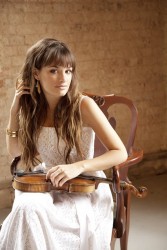
 United States Aspen Music Festival [7]: Aspen, Colorado. (HS)
United States Aspen Music Festival [7]: Aspen, Colorado. (HS)

5 August 2019, Jennifer Koh (violin), Percussion Ensemble / Jonathan Haas (conductor), Harris Hall
Julia Wolfe — Dark Full Ride, Part I
Charles Wuorinen — Percussion Quartet
Kati Agócs — Concerto for Violin and Percussion Orchestra
Parra — El Gavilán (Jaime Cárdenas-España, marimba/vocals)
Antheil — Ballet mécanique
6 August 2019, Nikolai Lugansky (piano), Harris Hall
Franck/Bauer — Prélude, fugue, et variation
Debussy — Deux arabesques; From Images, series 2
Franck — Prélude, choral, et fugue
Scriabin — Piano Sonata No.3 in F-sharp minor
7 August 2019, Nicola Benedetti (violin), Aspen Philharmonic / Robert Spano (conductor), Benedict Music Tent
Wynton Marsalis — Concerto in D for Violin and Orchestra
Copland — Symphony No.3
7 August 2019, Augustin Hadelich (violin), Orion Weiss (piano), Harris Hall
Debussy — Violin Sonata; L’isle joyeuse
Ysaÿe — Sonata for Unaccompanied Violin in E major
Brahms — Violin Sonata No.2 in A major
John Adams — Road Movies
8 August 2019, Simone Dinnerstein (piano), Harris Hall
Couperin — Les Barricades Mystérieuses; Le tic-toc-choc, ou Les maillotins
Schumann — Arabesque in C major, Op.18; Kreisleriana
Philip Glass — Mad Rush
Satie — Gnossienne No.3
It will be hard to top the one-two punch this past week of pianist Nikolai Lugansky and violinist Augustin Hadelich. Both were magnificent, and whether it was intentional or not, the music of Debussy stood out for both.
Beethoven’s Sonata No.4 in A minor and Brahms’s Sonata No.2 in A major were models of classical elegance, but Hadelich’s program sprang to life when he and piano partner Orion Weiss transformed the Debussy’s Violin Sonata into a rainbow of colors. The music emerged as if from a cocoon, starting quietly and simply, then gaining complexity naturally and gradually until it blazed at the finish.
In the Sonata for Unaccompanied Violin in E major, which Eugène Ysaÿe wrote in the style of the Spanish violinist Manuel Quiroga, Hadelich’s ability to transcend the mind-boggling demands of the notes made it into a tour-de-force of sun-drenched brilliance.
In the second half, Weiss’s solo spot brought technical clarity to Debussy’s L’isle joyeuses, and that set up an even more joyful romp with Hadelich in John Adams’s Road Movies, written in 1995 just as the composer started to break free of minimalism’s formal constraints. That spirit of American energy spilled over into the encore, Copland’s own bracingly effusive arrangement for violin and piano of ‘Hoe-Down’ from his ballet Rodeo.
Lugansky’s magic leavened his muscular power with astonishing technical mastery — avoiding heaviness that never tipped over into brittleness. His program rambled through French composers who straddled the late 19th and early 20th-century transition from high romanticism (César Franck) to impressionism (Claude Debussy), then finished with a stunning early example of Alexander Scriabin’s mysticism.
The pianist brought depth to Debussy’s Deux arabesques, contrasting the shimmering delicacy of the first with the grand flourishes of the second. He captured colors and textures of Images, Series 2 to paint the fluttering leaves against the chiming bells of ‘Cloches à travers les feuilles’ (‘Bells through the leaves’) and the gauzy longueur of ‘Et la lune descend sur le temple qui fut’ (‘Moon setting over the temple that was’), finishing with the quicksilver darting of ‘Poissons d’or’ (‘Goldfish’).
As bookends to the French portion, Lugansky found sustained feeling for Franck’s Prélude, fugue, et variation, originally an 1868 organ work, in Harold Bauer’s solo piano version from 1910. Likewise, Prélude, choral, et fugue, which Franck wrote for piano, revealed Lugansky’s ability to find directness in complexity.
As might be expected from a great Russian pianist, the Scriabin Third Sonata roared to life with its stormy opening movement, receded into soft colors in the second, turned sad in the third, and took magnificent upward leaps of ecstasy in the finale until the energy dissipated into resignation at the end — brilliant stuff.
Encores included a Rachmaninoff Prélude in G Major that made the pianistic flourishes feel inevitable and lovely, and Debussy’s extroverted ‘Jardins sous la pluie’ from Estampes, which brimmed with exuberance.
Sandwiched between these recitals, was perhaps the Aspen Philharmonic’s most important concert of the season. It included the debuts of a big new concerto by the musical polymath Wynton Marsalis, and the local debut of an extraordinary violinist, Nicola Benedetti. Between persistent rain that drowned out a good portion of the soloist’s contributions, the 45-minute concerto revealed itself as a work of originality, humor and polyglot style that ranged from sweet lyrical song to dashes of Celtic flavor, blues and stomping jazz.
Fortunately, the rain stopped early in the finale, a mashup of square dancing and broad gestures that called to mind Copland and Ives, finishing with a wistful song as the violin faded out. Finally, we could clearly hear Benedetti’s touch. She deserves a rain check.
Robert Spano conducted with a feel for the eclectic styles, drawing idiomatic playing from the all-student orchestra. The energy never dissipated, even if he tended to exaggerate dynamic contrasts in this work and Copland’s Symphony No.3. Spano got the orchestra to make its points.
In her recital in Harris Hall, pianist Simone Dinnerstein — another solo artist overshadowed by the splendor of Lugansky and Hadelich — focused on obsession. The centerpiece of the first half, Philip Glass’s Mad Rush (1973), kept returning to the same gestures. Two 18th-century Couperin miniatures and Schumann’s familiar Arabesque in C major surrounded the Glass. Each one enlightened the next, all played with appropriate intensity.
But the second half was not as satisfying. Following Satie’s slight, abstract Gnossienne No.3, Schumann’s Kreisleriana might have paid dividends if Dinnerstein’s pedal-heavy, stodgy reading had delivered more clarity and expressiveness.
The Percussion Ensemble’s daring program ended with a rousing go at George Antheil’s surreal, ear-splitting, audacious Ballet mécanique, for four pianos and a percussion battery than includes an insistent doorbell and a pre-recorded airplane propeller. The raucous (and much less accessible) Percussion Quartet by Charles Wuorinen was a beast, for both players and listeners.
There were gentler moments, too, starting with Dark Full Ride, Part 1, by Julia Wolfe (a co-founder of Bang on a Can) for four percussionists with an incessant rhythm on (mostly) hi-hats. From these cymbals mounted on poles and adjusted by pedals, the range of sound was a vivid demonstration of the capabilities of untuned percussion.
Inspired by Lou Harrison’s midcentury concertos for violin and percussion, composer Kati Agócs surrounded violinist Jennifer Koh with pairs of mallet instruments — vibes, xylophones, marimbas and glockenspiel — and only made drums prominent in the finale. Once a student in Aspen’s composition program, Agócs spun fluid and sometimes florid turns for Koh over busy (and mostly soft-textured) ear-friendly harmonies and rhythms.
Jaime Cardénas-España, a student percussionist from Chile, opened the second half by singing Chilean folk legend Violetta Parra’s heartbreaking ‘El Gavilán’ with his own glosses on a big marimba, an extraordinary nine minutes of fervent expression.
Harvey Steiman
